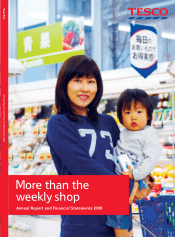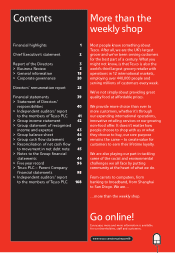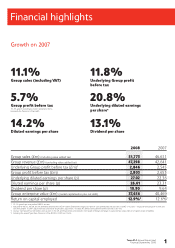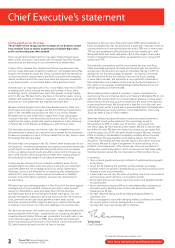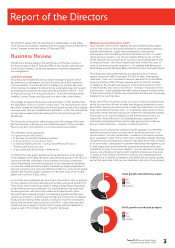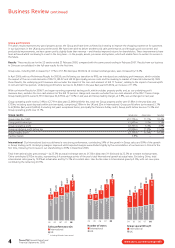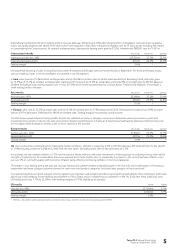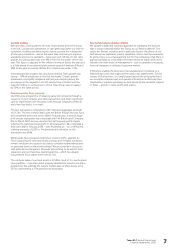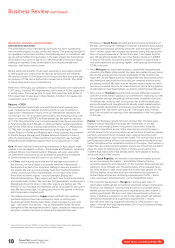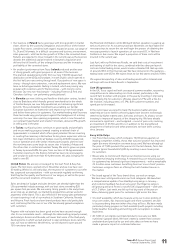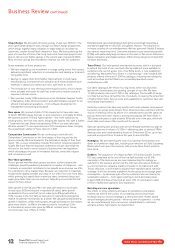Tesco 2008 Annual Report Download - page 5
Download and view the complete annual report
Please find page 5 of the 2008 Tesco annual report below. You can navigate through the pages in the report by either clicking on the pages listed below, or by using the keyword search tool below to find specific information within the annual report.
Tesco PLC Annual Report and
Financial Statements 2008 3
The Directors present their Annual Report to shareholders on the affairs
of the Group and Company, together with the audited financial statements
of the Company for the year ended 23 February 2008.
Business Review
This Business Review analyses the performance of the Tesco Group in
the financial year ended 23 February 2008. It also explains other aspects
of the Group’s markets, results and operations, including strategy and
risk management.
Long-term strategy
Tesco has a well-established and consistent strategy for growth, which
has allowed us to strengthen our core UK business and drive expansion
into new markets. The rationale for the strategy is to broaden the scope
of the business to enable it to deliver strong sustainable long-term growth
by following the customer into large expanding markets at home – such
as financial services, non-food and telecoms – and new markets abroad,
initially in Central Europe and Asia, and now also in the United States.
The strategy to diversify the business was laid down in 1997 and has been
the foundation of Tesco’s success in recent years. The new businesses which
have been created and developed over the last decade as part of this strategy
now have scale, they are competitive and profitable – in fact, the International
business alone makes about the same profit as the entire Group did a
decade ago.
The Group has continued to make progress with this strategy, which now
has five elements, reflecting our four established areas of focus, and also
Tesco’s long-term commitments on community and environment.
The objectives of the strategy are:
> to grow the core UK business;
> to become a successful international retailer;
> to be as strong in non-food as in food;
> to develop retailing services – such as Tesco Personal Finance,
Telecoms and tesco.com; and
> to put community at the heart of what we do.
In 2007/8, Tesco has again delivered a strong performance, with all parts
of the strategy contributing. We have sustained good growth in the UK and
coped well with the challenges of poor weather, recovering competitors,
and a deteriorating consumer background. In our international operations
we have also made excellent progress, completing a large programme of
new store openings and overcome difficult conditions in some of our largest
markets. We have also begun operations on the west coast of the United
States with our Fresh & Easy stores.
In non-food, more customers are choosing to shop with us even in a period
of more cautious consumer spending and we have seen good growth from
Tesco Direct, which extends our reach in selling a broad range of products
on the internet and via a catalogue. Our retailing services have delivered
another good year, with tesco.com sustaining its rapid growth, Tesco
Personal Finance making progress in challenging markets and Telecoms
continuing to build its customer base strongly and moving into profitability.
Finally, we are making strides towards a revolution in green consumption,
having reduced carrier bag use by over one billion – more than any other
retailer and are on target to sell ten million energy efficient lightbulbs in
a year as part of the Climate Group’s ‘Together’ campaign.
Markets served and business model
Tesco’s growth, driven by this strategy, has been predominantly organic
and we have used our skills and knowledge in understanding customers,
property development, supply chain management, new product
development, store formatting and how to localise our offer – to create
strong business models in our chosen markets. Where we do not have
all the required skills ourselves to be successful, we regularly partner with
existing businesses – and these relationships have formed the basis of
some of our most successful operations – for example with Samsung in
South Korea and with the Royal Bank of Scotland in Tesco Personal Finance.
The UK grocery retail market remains our largest source of revenue,
representing some 46% of last year’s £51.8bn of sales. International
retail sales – from our 12 markets in Europe, Asia and the United States,
comprise a further 19% of Group revenues and non-food (in a variety
of categories from health and beauty to electronics) accounts for most
of the remainder. Our services businesses – not least in financial services
and telecoms – have comparatively small revenue streams because some
of the most important of them are joint-ventures but they are increasingly
material to our earnings base.
At the core of Tesco’s business model is a focus on trying to improve what
we do for customers. We aim to make their shopping experience as easy
as possible, lower prices where we can to help them spend less, give them
more choice about how they shop – in small stores, large stores or online,
and seek to bring simplicity and value to sometimes complicated markets.
And we aim to be a good neighbour in the communities we serve, be
responsible, fair and honest in our dealings and give customers the
information and products they need to make greener choices. We are
also an inclusive business – everyone is welcome at Tesco.
Because we are a discounter, underpinning this approach is a relentless
attitude to being the lowest cost provider of goods and services in our
chosen sectors – and this combination of qualities is the reason we have
been successful in some of the world’s most competitive markets. We have
recognised skills and proprietory systems in key areas which help us deliver
a low cost model – particularly in customer relationship management, just-
in-time supply chain and distribution, property development and store
formatting. In some of our newer markets – such as telecoms or financial
services, our willingness to partner with established businesses has given
us access to their existing investment in systems and infrastructure and
enabled Tesco to develop competitive, profitable business models quickly
and, at the same time, limit our own investment and risk in the early years.
Report of the Directors
Sales growth contribution by region
1 UK
2 Asia
3 Europe
1
46%
2
25%
3
29%
Profit growth contribution by region
1 UK
2 Asia
3 Europe
1
50%
2
21%
3
29%

